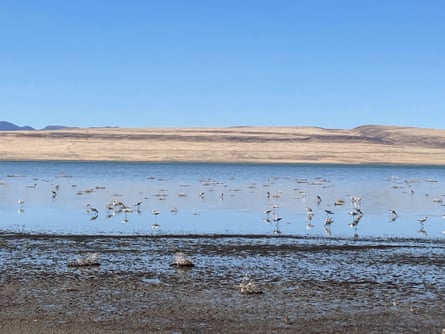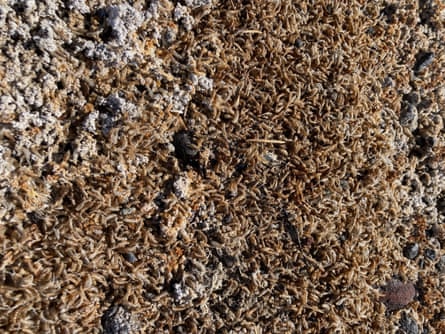“The survival of migratory birds hinges on this saline lake – yet it is slowly fading away.”
T
In July 2013, the water level of Lake Abert in Oregon dropped to an abnormally low point. This resulted in high salt concentrations that were not suitable for most species adapted to the lake’s saline environment. The population of small brine shrimp and alkali flies suffered mass die-offs. As the water continued to evaporate, the excess salts formed a glistening white layer of triangular crystals by September.
The number of shorebirds observed on a daily basis peaked at 350,000 in July, surpassing even the density found at the Great Salt Lake. However, due to the lake drying out and remaining vacant the next summer, bird sightings decreased by 90%.
Between 2014 and 2022, the lake experienced frequent droughts which greatly reduced the bird population. However, last winter’s unexpectedly high levels of precipitation helped restore some of the lake’s water. Despite this temporary improvement, scientists caution that the overall trend is still a decline, and the underlying causes of the lake’s dry spells persist.
Lake Abert is not well known, but it plays a crucial role for migratory birds adapted to living in salty inland waters. Unfortunately, it has dried up five times in the last ten years, causing conflict between conservationists and nearby ranchers who rely on the lake’s water for irrigation.
In 2022, after observing successful collaborations among conservation groups in the rural American west, the two groups ultimately agreed to join forces. They aim to use this collaborative approach to address issues like fire management and species conservation with different stakeholders.
Currently, the collaboration is being put to the test with a new challenge: the fact that in the west of America, affected by climate change, there is a lack of sufficient water supply for all.

Lakes without an outlet, known as terminal or sink lakes, are typically found at the bottom of closed basins. This phenomenon is prevalent in the western United States, where only a handful of significant and long-standing terminal lakes exist, such as Abert, the Great Salt Lake, Mono Lake, and the Salton Sea.
These closed-basin water systems differ from others because, as seventh-generation rancher Colleen Withers explains, “you only get one chance for water – what you see is what you have.”
The primary source of water for Abert is the Chewaucan River. During the spring, the river is redirected by ranchers into canals and marshes, where their cattle spend the winter and give birth in the spring. This helps provide a sustainable environment for the cattle.
The irrigation systems have been in place since the early 1900s, but there has been a gradual increase in water diversions over the years. If all of the water rights on the Chewaucan were currently utilized, they would exceed the river’s natural flow. Additionally, climate change has contributed to higher rates of evaporation from the river and lake.
This is concerning for conservationists and experts in the field because it has potential impacts on birds that live in coastal regions, specifically the Wilson’s phalarope and American avocet. These birds have adjusted to living near salty lakes, developing methods of feeding that reduce their consumption of salt and evolving specialized glands above their eyes to release excess salts.

Display the image in full-screen mode.
Phalaropes are drawn to saline lakes due to the high numbers of invertebrates. This is because there are no predators such as fish or other birds to consume the abundant flies and shrimp. According to Theo Dreher, president of the Oregon Lakes Association, “they are just dead easy to eat.” During their stay at Abert, the birds shed and gain twice their body weight before embarking on a difficult journey south to Argentina.
If these bodies of water experience water loss and become more salty, the invertebrates living there will not be able to survive and there will be insufficient food for the birds. These birds are extremely adapted to this unique environment and cannot survive in any other location. As approximately 10% of the shorebird population depend on Abert Lake, its decline could greatly impact these species.

“They are teetering on the brink in regards to their physical capabilities to endure – they rely heavily on these shallow, salty lakes,” states retired scientist and Oregon Lakes Association member Ron Larson.
“We hope to avoid the possibility of the population becoming too depleted to bounce back.”
R
Individuals who own land and ranchers have come together to create the Chewaucan Watershed Collaborative, in order to have a role in discussing the decrease of the lake. The ranchers stress the importance of viewing the entire Abert watershed.
For example, a large portion of the Fremont-Winema national forest, which includes the Chewaucan River, was affected by a fire in 2021 likely caused by prolonged drought. Tess Baker, a rancher who has been in the area for four generations, explains that the situation has greatly impacted the end point of the system, Abert.
Disregard the promotional newsletter.
after newsletter promotion
Baker, Withers, Dreher, and their respective partners convened in May 2022 to discuss potential collaboration. According to Dreher, “We quickly discovered that communication was effortless during those initial meetings.”
They asked for support from Oregon Consensus, an institution that sponsors complex conflict resolution, and spent the summer bringing together environmental groups, government agencies and local tribes to form the Partnership for Lake Abert and the Chewaucan.
Upon recognizing their differing opinions, the group members acknowledged the need for a more comprehensive understanding. As a result, they conducted a six-month research project to gather scientific evidence, traditional tribal ecological knowledge, and insights from ranchers.
One of the main differences relates to the ranchers’ water diversions. Ranchers argue that their flood irrigation mimics the way the marshes functioned before the land was settled and drained in the late 1800s.
The marshes are known to have a great variety of grasses, with approximately 50 different species, and are a popular destination for birds such as sandhill cranes, geese, and black-necked stilts. According to Keith Baker, Tess’s husband, there is a mutually beneficial relationship between the wildlife and ranching industry.
Several environmental groups and the Oregon state agency for fish and wildlife approved the implementation of flood irrigation in the 1980s. However, Dreher challenges the idea that this method replicates the natural water patterns of marshes and suggests re-evaluating its use due to the observed impacts of rising temperatures and water scarcity in the western region.
“During that time, it appeared that there was sufficient water volume for both the lake and irrigation purposes,” he explains. “However, that is no longer true.”
Other conservationists and scientists agree that Abert’s unique ecological function should be prioritised over marshland ecosystems that can be found elsewhere. “All the birds are important, and they all have their needs,” says Ryan Carle, science director of Oikonos Ecosystem Knowledge.
However, according to him, Lake Abert is the sole habitat that offers suitable conditions for certain shorebirds. On the other hand, while irrigating the basin for ducks is significant, there are also other habitats that are utilized by ducks.
According to Wilson Wewa, a member of the Warm Springs Paiute Tribe, it is the duty of ranchers to reduce their water usage. He states, “Water is limited and excessive use is leading to the collapse of [Abert].” He also believes that the land and lakes have a voice that is being ignored by society.

Enlarge the image.
In other areas, two primary methods have been implemented for preserving lakes. In California, legal actions based on the public trust doctrine – which requires states to safeguard bodies of water within their jurisdiction for the benefit of the public – set a minimum water level for Mono Lake. In September 2023, environmental organizations in Utah revealed their intention to file a comparable lawsuit for the Great Salt Lake.
An alternative solution is implementing a minimum flow mandate, in which a designated volume of the Chewaucan’s flow must reach Abert.
Currently, the members of the partnership do not have a defined objective, but they are optimistic that a solution will come about through their collaborative efforts. Keith Baker states, “Our goal is to bring water to Abert because it indicates the overall satisfaction of the system.”
Source: theguardian.com


